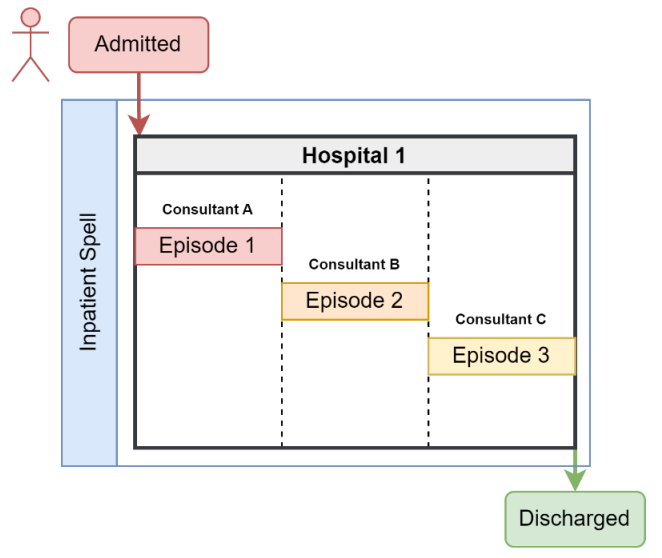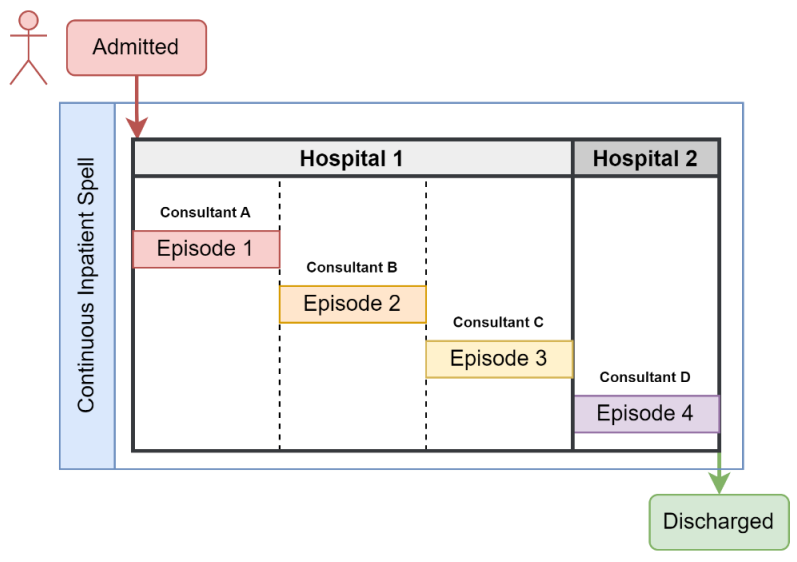8 Hospital Episode Statistics
HES contains hospital records for all NHS patients in England, including patient demographics and standardised codes for diagnoses, symptoms and procedures relating to the care they have received (NHS England, 2023g). The datasets are collected by NHSE from hospital care providers and curated on an ongoing basis. However, data from other health providers such as General Practitioners (GPs) or pharmacies are not included. HES datasets are collated by financial year and following processing and quality assessment, the finalised datasets are released for secondary use and remain unchanged thereafter (Boyd et al., 2018).
8.1 Admitted Patient Care
Records within the Admitted Patient Care (APC) dataset are called ‘hospital episodes’, and each episode relates to a period of care for a patient under a single consultant (consultant episode) within one hospital provider (Herbert et al., 2017; Boyd et al., 2018; Health Data Research, 2023b). The time from initial admission to discharge is called a ‘spell’, defined as ‘periods of continuous care in one provider institution’ and each admission spell can be made up of many episodes. APC data contain ‘Finished Admission Episodes’ (FAEs) which is the first episode in a spell of care, and ‘Finished Consultant Episodes’ (FCEs), which is a continuous period of care under one consultant. Only FCEs occurring within the financial year (up to midnight on 31st Mar) are included. Patients with an unfinished consultant episode in the current financial year will have their record represented as a finished episode in the next financial year of HES data.
8.1.1 Inpatient spell (single hospital)
A hospital admission commences when a patient is initially admitted for care and ends when a patient is discharged, transferred, or dies.
One spell of admission encompasses multiple episodes of care under an different consultant.

8.1.2 Continuous Inpatient spell (across multiple hospitals)
In some instances, admitted patients who require specialised treatment may be transferred from one hospital to another more specialist hospital, e.g., transfer to a Children’s hospital.

8.2 Attribute data: hospital attendance
| Dataset | Years | Details |
|---|---|---|
| Outpatients (OPA)1 | 2003 to 2023 | Outpatient appointments at English NHS hospitals and NHS commissioned activity in the independent sector (regardless of whether the appointment was attended or not) (NHS England, 2023i; Health Data Research, 2023d). In 2003/04, the OP module was considered experimental and did not have complete coverage as not all providers completed data submissions. |
| Accident & Emergency (A&E)2 | 2007 to 2020 | Attendance level dataset collecting information about the treatment received by patients attending A&E Departments, Minor Injury Units and Walk-In Centres, in England (NHS England, 2023e; Health Data Research, 2023a). |
| Emergency Care Data Set (ECDS)3 | 2020 to 2023 | In 2018, the A&E dataset was replaced by the ECDS which is now the national dataset for Urgent & Emergency care [NHS England (2023d); NHS England (2023c); hdr2023d]. |
8.3 Attribute data: admission
| Dataset | Years | Details |
|---|---|---|
| Admitted Patient Care (APC)4 | 1997 to 2023 | Episode-level dataset of patients admitted for treatment (i.e., requiring the use of a hospital bed), at NHS hospitals in England; includes delivery and birth data, up to 20 diagnostic codes per episode and procedure codes (Herbert et al., 2017; Health Data Research, 2023b; NHS England, 2024a). |
| Critical Care (CC)5 | 2007 to 2023 | Episode-level dataset of patients admitted for treatment and receiving Critical Care (intensive care or high dependency care) at NHS hospitals in England. Treatment in adult designated wards where constant support and monitoring are required to maintain at least one organ (i.e., an Intensive Care or High Dependency Unit) [Health Data Research (2023c); nhse2024c]. |
8.4 Attribute data: mental Health
| Dataset | Years | Details |
|---|---|---|
| Mental Health Services Data Set (MHSDS) | 2016 to 2023 | Patient-level dataset that records all activity relating to patients who receive assessments and treatment from Mental Health Services in England, where the patient has (or is thought to have): either a mental health condition; a need for support with their mental well-being; a learning disability; autism; or any other neurodevelopmental condition (NHS England, 2023m). |
| Mental Health & Learning Disabilities Data Set | 2014 to 2016 | Disabilities Data Set Data is collected from the health records of individual children, young people and adults who were in contact with mental health services (NHS England, 2024c). |
| Mental Health Minimum Data Set (MHMDS) | 2006 to 2016 | The MHMDS was the preliminary dataset capturing data about the use of Mental Health Services in England. However, the MHMDS was superseded by the Mental Health & Learning Disabilities Data Set, which in turn was superseded by the MHSDS (NHS England, 2024c). |
8.5 Attribute data: birth
| Dataset | Years | Details |
|---|---|---|
| Maternity Services Data Set (MSDS) | 2015 to 2023 | The MSDS is a patient-level dataset that captures information about activity carried out by Maternity Services relating to a mother and baby(ies), from the point of the first booking appointment until the mother and baby(ies) are discharged from maternity services. The MSDS collects records of each stage of the maternity service care pathway in NHS-funded maternity services and includes information not recorded in HES (NHS England, 2023a; Health Data Research, 2023e). |
| Birth Notification Data | 2001 to 2023 | Birth notification is a document completed by the doctor or midwife present at birth occurring in an NHS facility in England, Wales and the Isle of Man. Thebaby’s NHS Number is issued as part of the ‘statutory notification of birth’. Birth notification data includes information that is not found in the birth registration data such as gestation age and ethnicity of the baby as stated by the mother (NHS England, 2023b). |
| ONS Birth Registration Data6 | 1996 to 2022 | ONS Birth Registration Data includes information recorded when live births and stillbirths are registered as part of civil registration, a legal requirement, in England and Wales. The registration of births is a service carried out by the Local Registration Service in partnership with the General Register Office (GRO), in England and Wales. All registered births are included except very late registrations received more than 14 months after the end of each reference year (there are fewer than 100 of these for any given year) (Office for National Statistics, 2024). |
8.6 Attribute data: other
| Dataset | Years | Details |
|---|---|---|
| HES-ONS Linked Mortality Data | 1998 to 2023 | Since January 1998, HES data have been routinely linked to mortality data as recorded by the Office of National Statistics (NHS England, 2023k), and this information is also included in ECHILD. Mortality data contains information taken from the death certificate for all deaths registered in England and Wales and includes cause of death, date and place of death. Information related to stillbirths is not available in this dataset. |
| Community Services Data Set (CSDS) | 2015 to 2023 | The CSDS captures activity data about children and adults collected by Community Services, including health visiting teams. Such activities may take place in settings such as Health centres; Day care facilities; Schools or Community centres; Mobile facilities, or a patient’s own home (NHS England, 2023j). Data are collected about children and adults e.g., personal, demographic or social circumstances; breastfeeding and nutrition; long-term conditions (disabilities), diagnoses and scored assessments. The CSDS is comprised of patient-level data from all publicly funded community services providers e.g., Foundation or Non-Foundation Trusts; Acute Trusts; Mental health Trusts, Community Healthcare Trusts, Independent sector providers and Local Authorities. |
Diagnoses are recorded using the International Classification of Disease (ICD) version 10 and procedures are recorded using the Office of Population Censuses and Surveys (OPCS) version 4. Diagnoses and procedures have very low levels of completeness in the Outpatient dataset (5% and 26%, respectively) (Boyd et al., 2018).↩︎
Bespoke codes are used to record diagnoses and treatments (NHS England, 2023f); however, these are much more limited than ICD-10 and OPCS-4 codes. Prior to 2012/13, the A&E module was considered experimental and did not have complete coverage as not all providers completed data submissions (NHS England, 2023e).↩︎
ECDS uses a subset of SNOMED CT codes to record diagnoses and treatments (amongst other variables) (NHS England, 2023d, 2023c).↩︎
See footnote 1.↩︎
See footnote 1.↩︎
Inclusion of dataset within ECHILD is pending confirmation.↩︎